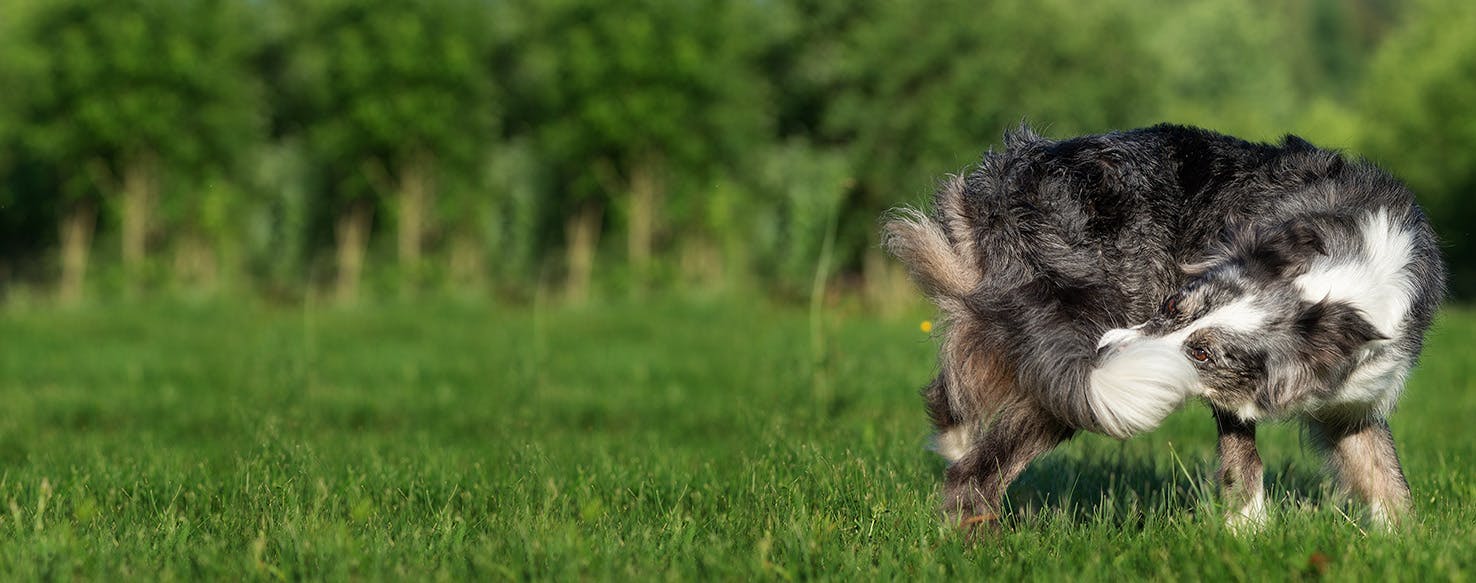- Home
- The Daily Wag!
- Behavior
- Why Dogs Bite Their Own Tail

Common
Normal
Watching your dog chase its own tail playfully is amazing, and never fails to bring on a smile. It is, after all, one of the most iconic dog behaviors of all time. That being said, you might have some concerns if you’ve noticed that your dog is starting to bite its tail frequently and compulsively.
Tail biting—especially when it becomes an obsessive habit—always has an identifiable root cause. The behavior could be the result of anything from boredom and stress to pain and health problems. If you want to better understand and address your dog’s tail-biting behavior, here are some common root causes that might have your dog obsessively catching its own tail.
Just like babies, puppies must learn to control their bodies after they are born. At first, they tend to stumble around adorably, inspecting everything they can get their little, wet noses into. As they grow and learn about the exciting world around them, they begin to gain mastery over their motor skills. It is sometime during this coordination phase that they seem to discover a built-in, happily wagging toy at the opposite end of their body. While this is not an absolute case for all dogs across the board, many pups begin to engage with their tails simply out of playful curiosity.
Adrienne Farricelli, who is certified by the Certification Council for Professional Dog Trainers, believes that frequent and concerning tail-biting behavior is the result of either health problems or behavioral issues. Before looking into behavioral issues, she recommends ruling out health problems. Irritations and parasites are the two most probable causes for sudden increases in tail biting, and these are sometimes accompanied by whining. It is not unusual for a younger dog to experience irritations from allergies, bug bites, or small cuts on their behinds, and this may lead them to bite at the area of irritation. If your dog is biting its tail aggressively, it may be due to those terrible, tiny parasites that every dog owner fears: fleas. They love a dog’s tail, and fleas may themselves be carrying other harmful parasites like tapeworms or mites.
If the root of your dog’s tail biting is not a health problem, it may be that your dog has simply developed a bad habit. Although puppies usually outgrow tail biting, there are several circumstances which might cause the behavior to grow into something more than just an innocent game. If your dog is constantly seeking your attention, it could be that you have accidentally reinforced the behavior by repeatedly laughing, making eye contact, or even scolding your dog during the behavior. On the other hand, if your dog feels neglected and spends long periods of time alone, the tail might become a coping mechanism for boredom, frustration, stress, or anxiety. If the problem is behavioral, you might be able to help the situation by changing something about the way you interact with your dog.
Need advice about your pet's health?
Get answers fast from a veterinary professional 24/7 in the Wag! App.
Get Vet ChatIf your little buddy is still getting those little puppy feet underneath him, it may not yet be time to worry about tail-chasing behaviors. You can still check for any abnormal irritations around your puppy’s tail and should look for any cuts, sores, pus, crusts, unusual smells, or redness on or around the base of the tail. If the issue is fleas, your dog may be displaying other behaviors like scratching or restlessness. Don’t rule out fleas simply because you cannot see them; look for tiny black flea droppings around the house that turn red when you drop water on them. The end-all for any health-related problem with your is a trip to the veterinarian, but you may be able to do the groundwork yourself and avoid the cost of an office visit.
If your little buddy is no longer a puppy, and you’ve ruled out health concerns, then you might look into behavior training. Try introducing your dog to intriguing games or toys that will stimulate your dog’s mind and reduce boredom. Going for walks in new areas or setting playdates with other pups may assist your dog in outgrowing his fascination with his tail. If you notice that your dog only chases and bites its tail around you, ask yourself how your behavior might be fueling your dog’s behaviors. You can stop attention-seeking tail biting by simply ignoring it, and this includes both positive and negative attention. Over time, your dog may simply catch on and change behaviors. Still, your dog’s behaviors might continue to increase and worsen, and you might be wondering what to do then.
If you feel that you have tried everything in your power and your dog’s behavior is becoming more and more concerning, the issue may be more severe. Dogs that are regularly left alone for long periods of time might develop an obsessive disorder around tail-biting. The problem may be that your dog has an underlying condition that causes it to be in chronic pain, and they may cope with this pain by tail biting. Less common parasites may have infected your dog, and may be causing your dog severe stress or discomfort. In all of these cases, the only solution is to seek out a veterinarian, who can then diagnose and prescribe a treatment solution.
For the most part, you will be able to enjoy your dog’s tail-chasing days until they come to a natural conclusion. If the behavior escalates and you find yourself chasing your own tail trying to come up with a way to stop your dog from biting itself, try out these solutions, and help your dog grow up to be healthy, happy, and smart.
Written by a Shiba Inu lover Patty Oelze
Veterinary reviewed by:
Published: 02/06/2018, edited: 01/30/2020
More articles by Patty Oelze

